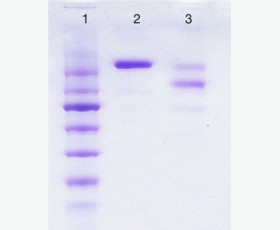Recombinant Human Carboxypeptidase A1/CPA1
| Product name: | Recombinant Human Carboxypeptidase A1/CPA1 |
| Source: | Human Cells |
| Purity: | Greater than 95% as determined by reducing SDS-PAGE. |
| Buffer Formulation: | Supplied as a 0.2 μm filtered solution of 20mM TrisHCl, 150mm NaCl, pH 7.5. |
| Applications: | Applications:SDS-PAGE; WB; ELISA; IP. |
| Storage: | Avoid repeated freeze/thaw cycles. Store at 2-8 oC for one month. Aliquot and store at -80 oC for 12 months. |
| UOM: | 100ug/50ug/200ug/1mg/1g |
| Source | Human Cells |
| Description | Recombinant Human Carboxypeptidase A1 is produced by our Mammalian expression system and the target gene encoding Lys17-Tyr419 is expressed with a 6His tag at the C-terminus. |
| Names | Carboxypeptidase A1, CPA1, CPA |
| Accession # | P15085 |
| Formulation | Supplied as a 0.2 μm filtered solution of 20mM TrisHCl, 150mm NaCl, pH 7.5. |
| Shipping |
The product is shipped on dry ice/ice packs. |
| Storage |
Store at < -20°C, stable for 6 months after receipt. Please minimize freeze-thaw cycles. |
| Purity |
Greater than 95% as determined by reducing SDS-PAGE. |
| Endotoxin | Less than 0.1 ng/µg (1 IEU/µg) as determined by LAL test. |
| Amino Acid Sequence |
KEDFVGHQVLRISVADEAQVQKVKELEDLEHLQLDFWRGPAHPGSPIDVRVPFPSIQAVKIFLES HGISYETMIEDVQSLLDEEQEQMFAFRSRARSTDTFNYATYHTLEEIYDFLDLLVAENPHLVSKI QIGNTYEGRPIYVLKFSTGGSKRPAIWIDTGIHSREWVTQASGVWFAKKITQDYGQDAAFTAILD TLDIFLEIVTNPDGFAFTHSTNRMWRKTRSHTAGSLCIGVDPNRNWDAGFGLSGASSNPCSETYR GKFANSEVEVKSIVDFVKDHGNIKAFISIHSYSQLLMYPYGYKTEPVPDQDELDQLSKAAVTALA SLYGTKFNYGSIIKAIYQASGSTIDWTYSQGIKYSFTFELRDTGRYGFLLPASQIIPTAKETWLA LLTIMEHTLNHPYVDHHHHHH
|
| Background | Carboxypeptidase A1 (CPA1) is secreted as a pancreatic peptidase that comes from the precursor form of inactive procarboxypeptidase. CPA1 comprises a signal peptide, a pro region and a mature chain, and can be activated after cleavage of the pro peptide. It has a free C-terminal carboxyl group, with the preference of residues with aromatic or branched aliphatic side chains. CPA1 cleaves the C-terminal amide or ester bond of peptides and involves in zymogen inhibition. Three different forms of human pancreatic procarboxypeptidase A have been isolated. In contrast to procarboxypeptidase B which was always secreted by the pancreas as a monomer, procarboxypeptidase A occurs as a monomer and/or associated to one or two functionally different proteins, such as zymogen E. |














